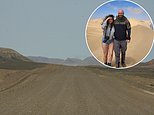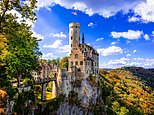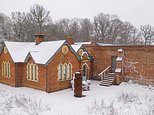
‘You think you know them,’ our tour guide, Hannes, pauses ominously, ‘You never know them.’
He’s talking about the shifting dunes of Sandwich Harbour in Namibia.
It’s a scene depicted on screensavers worldwide; towering dunes of the Namib Desert plummet abruptly into a thin stretch of sand and the crashing waves of the South Atlantic Ocean.
With a permit, expertise, and a little bit of grit, it’s possible to traverse these ever-changing sands in a trusty 4WD.
But even Hannes, who owns a business taking tourists into Sandwich Harbour, carries an emergency radio at all times.
The craziest part is that my boyfriend and I are about to head north alone, spending two days road-tripping the Skeleton Coast, aka the deadliest coast in the world.
We’re both taking notes.
Namibia’s western coastline is not for the faint-hearted.
Eibhlis Gale-Coleman and her boyfriend at Sandwich Harbour, Namibia, before they head north alone, spending two days road-tripping the Skeleton Coast, aka the deadliest coast in the world
With a permit, expertise, and a little bit of grit, it’s possible to traverse these ever-changing sands in a trusty 4WD – but Namibia’s western coastline is not for the faint-hearted
From ‘Gates of Hell’ to ‘The Land God Made in Anger,’ its nicknames reveal nothing short of an awful reputation
From ‘Gates of Hell’ to ‘The Land God Made in Anger,’ its nicknames reveal nothing short of an awful reputation.
At some point, someone settled on ‘Skeleton Coast’ – inspired by its 300 recorded shipwrecks – but its exact boundaries remain debated.
Some say it stretches from Angola to the Swakop River, while others classify it strictly within the Skeleton Coast National Park.
Alternate claims suggest it includes the whole stretch where the Namib Desert meets the ocean – if you’re judging by shipwrecks and carcasses, the latter probably wins.
Death lingers everywhere, from whale bones to the orange shells of extinct oysters. It seems like everything has come here to die.
Hitting the road, we wave goodbye to Hannes.
Our 393km (244mi) itinerary stretches from Walvis Bay to Torra Bay, with an overnight stay in the sailor-themed digs of Cape Cross Lodge.
The total driving time is around five hours, with an extra few hours allocated for detours.
At some point, someone settled on ‘Skeleton Coast’ – inspired by its 300 recorded shipwrecks – but its exact boundaries remain debated
Death lingers everywhere, from whale bones to the orange shells of extinct oysters. It seems like everything has come here to die
The Skeleton Coast’s microclimate also creates near-constant fog, which churns up with dust from passing vehicles — think constant headlights, even in mid-morning
With our rented Ford Ranger and rooftop tent, we’re hoping our equipment stands the test.
In the rearview mirror, Walvis Bay’s backdrop of shipping containers, stacked in primary colours like metallic Jenga, drift away.
It doesn’t take long to realise that the loosely gravelled C34 is a hazard.
Part sand, part scree, it’s a question of praying for traction and maintaining a steady speed.
The Skeleton Coast’s microclimate also creates near-constant fog, which churns up with dust from passing vehicles — think constant headlights, even in mid-morning.
These distant lights twinkle, merging with mirages along the road.
The C34 itself sits between desert and sea.
Hyenas and jackals prowl at night, and for the truly unfortunate, there’s a risk of desert lions who’ve begun returning to the coastline.
Hyenas and jackals prowl at night, and for the truly unfortunate, there’s a risk of desert lions who’ve begun returning to the coastline
I’ve never understood the phrase ‘deafening silence’ before. Yet, after an hour of unmarked desert driving, Sougat Swimhole greets us with an almost painful emptiness
A lioness just recently killed a philanthropist in Hoanib Camp.
In the day, these ‘land threats’ remain mostly invisible (unless you’re sharp-eyed enough to spot their tracks).
However, the ocean wears its wrath on its sleeve.
Its Benguela Current has run ships aground for centuries, and within an hour, Zeila Shipwreck looms on the left.
Destined for Indian scrap metal, the trawler was torn loose in 2008. Nobody came back for it, and I don’t blame them.
We stop for a few minutes, snap some photos, and gladly hop back into the car. Something about the slowly-rusting metal sends shivers down your spine.
These abandoned traces of industrialisation, whether that’s ships or diamond mines, dot the coastline.
In one spot, an excavation site flooded with ultra-saline water, forming Sougat ‘Dead Sea’ Swimhole, a bright-green lake where swimmers float effortlessly from the salt.
A hairy stretch of beach driving rewards us with sights of Winston Shipwreck on the horizon, and shortly after, we return to the sands to peer at the burned-out engine of Benguela Eagle Wreck
I’ve never understood the phrase ‘deafening silence’ before.
Yet, after an hour of unmarked desert driving, Sougat Swimhole greets us with an almost painful emptiness.
My boyfriend swims first (too many dead bugs for my liking), but after seeing his legs whoosh up as he gives a two-handed wave, I can’t resist wading in.
Its eeriness is otherworldly, and we bob with whispered giggles.
By the time we reach Cape Cross that evening, our skin is searing in a stinging layer of salt — but wow is it worth it.
After the tales of wandering lionesses, rooftop camping has rocketed my anxiety.
Still, Cape Cross Lodge feels secure.
Flanked by a colony of 210,000 foul-smelling seals, its camping spots have high walls and hearty set menus in a restaurant overlooking the water.
Our final stop is the rusted Old Oil Rig, a multi-tiered contraption that failed to find anything of value and is now known for its resident family of jackals
Exiting the park, my opinion on the Skeleton Coast is set in stone. It’s not somewhere to enter flippantly
Fed and rested, the final day comes too soon.
A hairy stretch of beach driving rewards us with sights of Winston Shipwreck on the horizon, and shortly after, we return to the sands to peer at the burned-out engine of Benguela Eagle Wreck.
By afternoon, we enter the ‘official’ territory of Skeleton Coast National Park, grabbing free permits before driving through an ominous skull-and-crossbones.
Our final stop is the rusted Old Oil Rig, a multi-tiered contraption that failed to find anything of value and is now known for its resident family of jackals.
Exiting the park, my opinion on the Skeleton Coast is set in stone. It’s not somewhere to enter flippantly.
There are rules to the game: satellite phones, full fuel tanks, strict camping guidelines, and absolutely no ocean swimming. Driving is sometimes tiring, and the road is constantly ready to take advantage of that, throwing a skidworthy bend or sudden pothole.
Spooky but perspective-inducing, it’s to be visited, not trifled with.
Source link
CHECK OUT: Top Travel Destinations
READ MORE: Travel News



